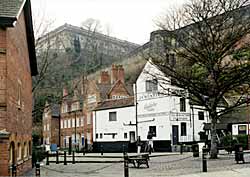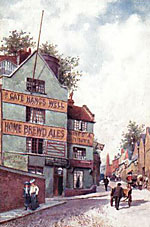
Ye Olde Trip to Jerusalem, Brewhouse Yard, Nottingham, in 2000.
We have now to deal with the two inns which alone, as licensed houses, have survived to our own day—” The Trip to Jerusalem” and the “Hanging Gate.” These buildings have no architectural merit. They are simply “fronts” that have been added to the ancient “rockhouses,” and all interest is centred in the remarkable chambers in the rock, and the romantic stories in connection with them. These chambers were undoubtedly used as dwellings from the very earliest time, but there is no recorded evidence that they were ever used as inns. In Thoroton’s “Prospect of Nottingham from the Meadow on the South side” (p. 489) three chimneys are shewn issuing from the top of the rock, which may indicate that they were still used as dwellings, or for trade purposes, but there is no authentic documentary evidence as to buildings earlier than 1760, when one of the houses was sold, being described in the deed of conveyance as “a messuage with garden and piece of ground adjoining, commonly known by the name or sign of “The Pilgrim.” In the 1799 Directory the sign is given as “The Trip to Jerusalem.” Just when, and why, this change was made will probably remain in uncertainty. The earliest notice of the change in the deeds is in 1834, when George Langford sold the house “formerly known by the sign of the Pilgrim but now by the name of the Trip to Jerusalem.” In the “History of Signboards” (published 1884), by Jacob Larwood and John Camden Hotten (p, 434), the authors say:— “Jerusalem was sure to figure early on signboards of those inns at which Pilgrims, on their way to the Holy Land were wont to put up; and long after pilgrimages were discontinued it was still retained as a sign”—and then, after enumerating some of the signs in France as well as in England, they continue:—“A similar idea seems to be conveyed by the sign of ‘Trip to Jerusalem, a public house in Nottingham.”
Frederick W. Hackwood in “Inns, Ales & Drinking Customs of Old England” (1909, p. 301) says the City of Nottingham boasts the curious sign, the “Trip to Jerusalem,” which dated from the days of pilgrimages, and was not inappropriately situated in Brewhouse Yard.”
The sign painted on the corner of the house contains these words:—Ye Olde | Trip to | Jerusalem | Inn | AD. 1199.
The trade card of mine host, which is distributed in thousands, and sent to every quarter of the globe, contains a view of the house and gives the following information respecting the origin of the name: “It will be found on reference to old historical books that it was so called in King Richard the First’s Reign, A .D. 1189. When the Crusaders left for Jerusalem to fight in the Holy Land they stopped at this Inn for refreshment.” The 3rd Crusade, the one in which Richard the Lion-heart played such an important part, took place 1190-1194, so that the date on the card A.D. 1189, would be all right; but the date painted on the sign, A.D. 1199, is, if I may be allowed to use a slang expression, “a little bit off,”—unless it be that the author thought that it was unnecessary to go beyond what the lawyers call “time immemorial,” i.e., the reign of Richard I.
The story continues thus—” the excavated rock rooms, in which Mortimer and Queen Isabella met in secret; also the room from which Mortimer was taken prisoner, in the year 1330, whilst in consultation with the Bishop of Lincoln, are to be seen.” And so the great public, ever eager for a romantic story, are contented.
I have not seen, nor do I know of the “historical books” from which the quotations are taken, but I have a suggestion of my own to offer as to the origin of the name. Thoroton (p. 490) wrote . “The Brewhouse Yard is a Constablery, wherein there are many houses, some in the Rock, others out of it, all which, being now of no Parish are a great Receptacle for Fanaticks, & other like people who would not live conformable to the Laws.” That was the Doctor’s opinion in 1677, but, in fairness, we must always remember that he was a devout Churchman, a staunch Royalist, a County Magistrate, and a hater of all Puritans and Nonconformists, and especially Quakers, and therefore he may have written somewhat harshly. But his testimony does not stand alone. About 80 years later Deering (p. 46) gives an account of the “Philadelphians,” a religious sect who used to meet there, calling themselves by the English name of a “Family of Love,” who would refer to their members as “Pilgrims,” and who professed to “bear love to all men, tho’ never so wicked,” &c. I suggest, therefore, knowing all these facts, and taking into consideration the spirit and temper of the age, that the name of “The Pilgrim” was a skit upon the reputation of the yard, and particularly upon the fanatical sect that formerly met there—possibly on the very spot where this inn now stands.
Judging by what I have actually seen, the Yard has not yet altogether lost its ancient reputation, and there are more citizens who have made pilgrimage to the “Trip to Jerusalem” than would be willing to own it—or to have the fact symbolically represented on their tombs. But if any of you have never been there, the place is really worthy of one visit.
Of this house it may truly be said “it is more in the rock than out of it,” for it contains not only cellars, which are remarkable, even in a place like Nottingham, which is famed for its ale-cellars—the temperature varying but two to three degrees all the year round—but “rock-chambers,” which are still licensed for trade. The large chamber, now used as the music-room, is lighted by means of an overhead shaft. This room is undoubtedly one of the malting floors of the old Castle. Out of the shaft, high overhead, a passage is said to lead to the secret chamber where Mortimer and Isabella held their tryst. An attempt has been made in these later days to add further interest to this chamber by pointing to it as the place where the celebrated criminal, Charles Peace, eluded his pursuers by climbing up the shaft and escaping through the Castle grounds. A search of the Police Records, however, gives no support to this story. A smaller rock-chamber contains a collection of curios, but none of them are of local interest excepting a ponderous padlock and key, which is said, with great probability, to have once belonged to the stocks in the yard, for “since King James’ reign, Brewhouse-yard has had a constable and overseer.” Orange, vol. I., p. 485.
The brewhouse is also in the rock, and ale is brewed to-day, perhaps not in the same way, but in the very same place where it has been brewed for centuries past. A peculiar feature here to be noticed is a horizontal bore-hole in the rock, about 2in. diameter, extending no one knows how far. It is known colloquially as the “speaking tube” from the Castle, but its real purpose probably was to carry a pipe-track from the brewhouse to the cellars.
There are numerous blocked-up passages and concealed doors, of long-forgotten use. One of these doors, however, has a very useful purpose to serve, being connected with what is perhaps the most remarkable feature of these rock-chambers, viz., the chimneys. The flues are carried up, some thirty feet or more, through the rock to the level of the outer court of the Castle, where they are finished off with brick stacks. The process of sweeping these unique flues is done from the top, the soot and sand falling down into a chamber prepared to receive it, by the side of the kitchen fireplace, and removed from thence by means of a concealed door. It is not necessary to sweep the chimneys often, as you may suppose, when I tell you that on the last occasion, some twelve years ago, 7 tons 15 cwts. of soot and sand were removed from one flue.
The kitchen and scullery are also rock-chambers; the floors are partly paved with very large hard-burnt bricks (said to be Roman, of course?), size 16in. long by 5½in. wide. One or two of the original doors of thin moulded oak framing still remain in situ.

The Gate Hangs Well as depicted on a Tuck's postcard from the early 1900s.
“The Gate Hangs Well “—by no means an uncommon name for an inn—the house on the north side of the entrance to the yard, recently closed under the Compensation Clauses of the Licensing Act of 1904, will soon be a thing of the past. It has been referred to under various names. At first it was “The Hanging Gate”; in the Directory of 1799 it was “The Sign Hangs Well,” and at the time of writing “Ye Olde Gate” could still be seen painted on the front, and the side, beneath the picture of an ordinary four-barred field gate. The name by which the house is known to the present generation is “The Gate Hangs Well.” Many suggestions have been offered to account for this designation, but whatever the origin of the name may have been, I think that the verse painted on the five-barred hanging gate sign, was intended to refer to the gate which prohibited any one, even the Constable of the Town, from entering the yard without the consent of the occupants. The emphasis should therefore be put upon the first word of the rhyme:—This gate | hangs well and hinders none | Refresh and pay | and travel on.
Various renderings of this rhyme are to be met with. Hackwood (p. 310) gives
“This gate hangs well and hinders none,
Drink, hearty boys and travel on,”
AND
“This gate hangs here for you to tell Bill Spriggins has good beer to sell.”
The house contained nothing of interest, other than a large rock-chamber, one of the old malting floors, with “a hole at the top for the admission of light, on which account it has obtained the name of the star parlour.” (Orange, vol. I., p. 485).
Unfortunately the deeds, which only go back as far as the year 1880, do not help us to throw light upon the early history of the place.
